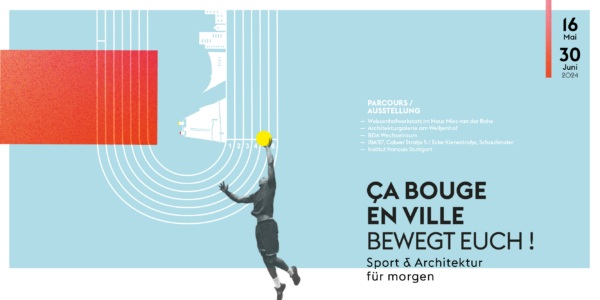

« Ça bouge en ville – Let’s move ! Sport and architecture of tomorrow »
From 16 May to 30 June 2024, discover in Stuttgart the ‘Ça bouge en ville – Let’s move!’ exhibition trail, dedicated to the place of sport in the city of tomorrow.
five partner organisations – The French Institute in Stuttgart, the Weissenhof Architecture Gallery, IBA’27 Friends, BDA Baden-Württemberg and the Weissenhofmuseum at Maison Le Corbusier – invite you to discover the exhibition ‘Ça bouge en ville! – Let’s get moving!’ exhibition in the form of a journey between several locations in Stuttgart.
It begins at the Weissenhof studio in Mies van der Rohe’s house and is devoted to the union of Le Corbusier’s architecture and the practice of sport. The second stop is the Weissenhof architecture gallery. Issues relating to space concepts and sustainable sports facilities are presented. Visitors should then plan to spend around 50 minutes (3.6 km) walking from the north of Stuttgart through the city centre to the next stop, the BDA Wechselraum (near the main railway station), where forward-looking concepts dealing with the conditions and prerequisites for sport in the urban space will be discussed. Via an intermediate station, the IBA’27 area (Calwerstr./corner Kienestr.), visitors can reach the fifth and final station, the Institut français on Berliner Platz. Here, it’s all about e-sports.
Developed in 2023 by the Le Corbusier Firminy site in collaboration with the architecture firm DREAM, this exhibition looks at the place of sport in the city of tomorrow.
The practice and perception of sport has changed in recent years. During the pandemic, for example, urban centres were transformed into open-air sports halls. In 2022, the organisation of the Football World Cup in Qatar triggered a wave of indignation. The constant media coverage of professional sport and its players reveals its growing role and the challenges it faces in modern society. It is now an institutional organisation at the heart of regional political strategies.
Ever since the first international congresses on modern architecture in the 1930s, there has been a growing awareness of the influence of sport on the organisation of space on a city-wide scale. In Firminy, Le Corbusier’s Centre de repos du corps et de l’esprit is an example of functionalist urban planning, where people not only have to work, but also have access to leisure activities.
Today, changes in leisure sports practices go hand in hand with the renewal of architectural programmes in cities undergoing major change. The exhibition presents an initial approach based on immersive and innovative trial and error tools.